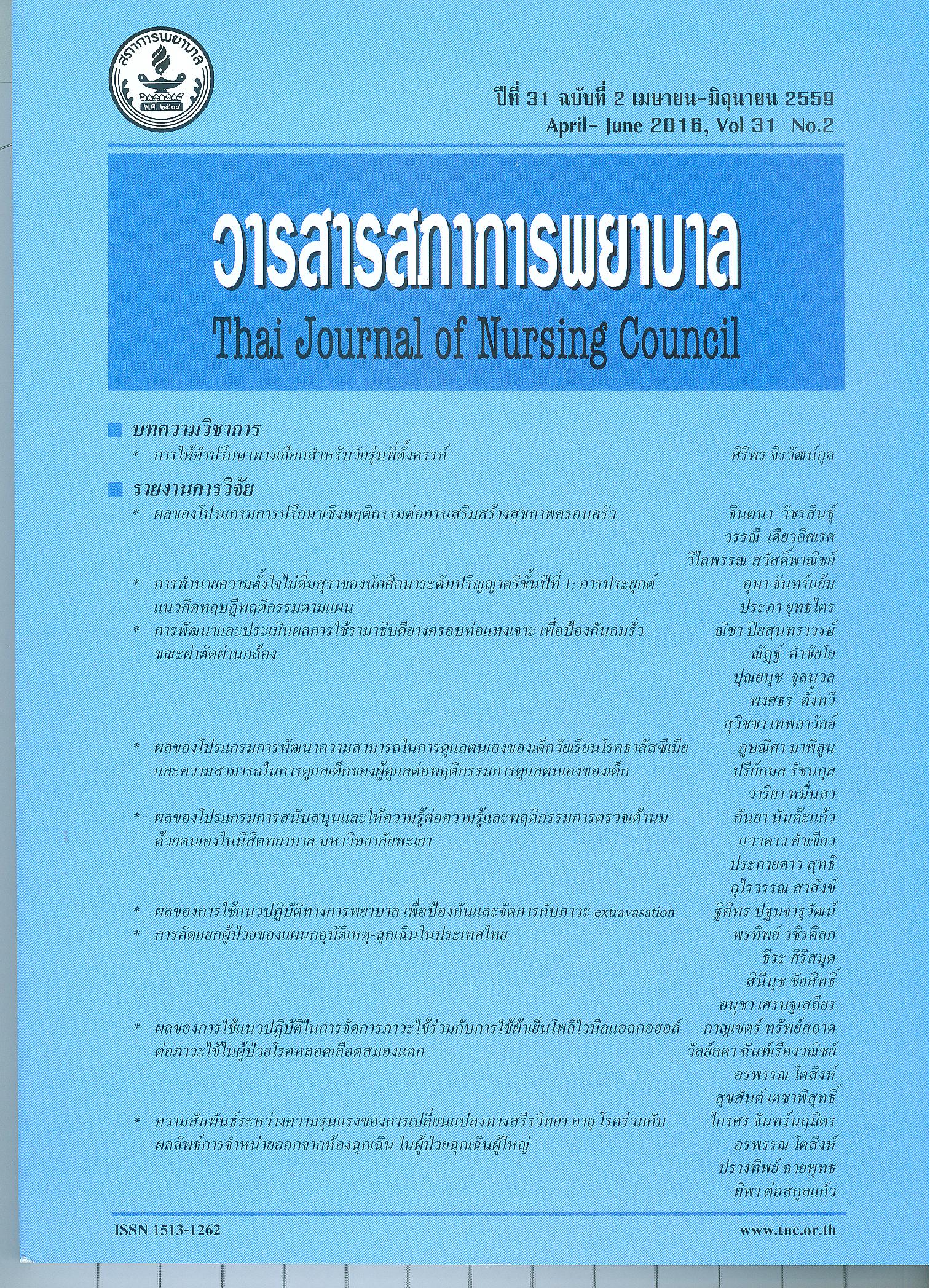การคัดแยกผู้ป่วยของแผนกอุบัติเหตุ-ฉุกเฉินในประเทศไทย
Keywords:
ระบบคัดแยก, แผนกอุบัติเหตุ-ฉุกเฉิน, โรงพยาบาล, triage systems, emergency department, hospitalAbstract
วัตถุประสงค์ของการวิจัย: เพื่ออธิบายและสำรวจสถานการณ์ระบบคัดแยกผู้ป่วยของแผนกอุบัติเหตุ-ฉุกเฉินในประเทศไทย
การออกแบบวิจัย: การวิจัยเชิงสำรวจแบบเร่งด่วน
การดำเนินการวิจัย: กลุ่มตัวอย่างเป็นบุคลากรทางการแพทย์ จำนวน 178 คน ที่ปฏิบัติงานแผนกอุบัติเหตุ-ฉุกเฉินในโรงพยาบาลทั่วไปสังกัดกระทรวงสาธารณสุข และโรงพยาบาลที่สังกัดมหาวิทยาลัย ใน 13 เขตบริการสุขภาพ จำนวน 105 แห่ง เครื่องมือในการรวบรวมข้อมูลใช้แบบสอบถาม สนทนากลุ่ม และสัมภาษณ์รายบุคคล วิเคราะห์ข้อมูลเชิงปริมาณด้วยสถิติเชิงพรรณนา และวิเคราะห์เชิงเนื้อหา
ผลการวิจัย: โรงพยาบาลเกือบทุกแห่งมีจุดคัดแยกเฉพาะ (ร้อยละ 87.9) โดยพยาบาลวิชาชีพเป็นผู้ที่ทำการคัดแยก ณ จุดคัดแยก (ร้อยละ 98.3) สำหรับระดับและสัญลักษณ์สีที่ใช้ในการคัดแยกระดับความฉุกเฉินส่วนใหญ่ใช้ระบบคัดแยก 5 ระดับตาม ESI (ร้อยละ 75.8) รองลงมา ระบบคัดแยกแบบอื่น ๆ (ร้อยละ 12.4) โรงพยาบาลบางแห่ง แม้จัดระบบคัดแยก 5 ระดับเหมือนกัน แต่สัญญลักษณ์สีแตกต่างกัน เมื่อพิจารณาระบบคัดแยกผู้ป่วยฉุกเฉินตามเขตบริการสุขภาพ พบว่า เขตบริการสุขภาพที่ 4 และ 7 มีการใช้ระบบคัดแยก 5 ระดับทั้งเขต และเขตบริการสุขภาพที่ 13 มีการใช้ระบบคัดแยกที่หลากหลายมากที่สุด การเปรียบเทียบระบบคัดแยกกับเขตบริการสุขภาพ พบว่า แต่ละเขตบริการสุขภาพมีการใช้ระบบคัดแยกแตกต่างกันอย่างมีนัยสำคัญทางสถิติ (p < 0.05) บุคลากรที่ทำการคัดแยกมีความรู้และประสบการณ์แตกต่างกัน ซึ่งส่งผลต่อคุณภาพการคัดแยก โดยอาจต่ำหรือสูงกว่าเกณฑ์ มีอุบัติการร้องเรียนบ่อยครั้งของผู้รับบริการที่แผนกอุบัติเหตุ-ฉุกเฉินเกี่ยวกับการรอคอยนาน ทั้งที่มีการประชาสัมพันธ์เกี่ยวกับการจัดลำดับบริการตามอาการฉุกเฉินของผู้ป่วย
ข้อเสนอแนะ: ควรมีการพัฒนาระบบคัดแยกผู้ป่วยฉุกเฉินให้เป็น 5 ระดับ ทั้งประเทศและยืดหยุ่นตามความพร้อมของเขตบริการสุขภาพ รวมทั้ง พัฒนาคุณภาพผ่านกระบวนการ PDCA สู่วิจัย R2R
Objective: To assess the current status and illustrated the problem of Thailand emergency department triage systems.
Design: Rapid survey
Implementation: The participants were 178 registered nurses working in emergency department in tertiary care hospitals of Ministry of Public Health and University hospitals. The research instruments were a personal information, a survey questionnaire and structured interview questions. The data were analyzed using Chi-square test, Fisher Exact Probability Test and content analysis.
Results: Almost all hospitals have a triage zone (87.9%), where the assignment was mainly done by a nurse (98.3%). In order to assess and identify the priority of the patient’s need for medical treatment, most hospitals (75.8%) use the Emergency Severity Index (ESI) approach to classify patients into 5 levels with different colors. Following the ESI approach, some hospitals (15.2%) may also classify the triage into 3, 4, 5 levels with different conventional classifications both symbols and colors.
When inspecting the triage system of the emergency department services, region 13 had the most variety, the triage system in regions were significantly difference (p<0.05). The difference in the staff knowledge and experience influences the triage quality. Both of under and over triage were observed among in experienced nurses and related health care personnel. Frequent complaints from the patients about long waiting time, despite having publicized that the treatment is prioritized on the severity of patient injuries.
Conclusion and Recommendations: It is recommended that ESI approach should be announced as the national policy by National Institute of Emergency Medicine. This approach should be clearly identified and promoted to use for patient triage. Quality improvement projects as well as evaluative researches are recommended to strengthen the quality of triage among nurses in emergency room.
Downloads
References
Reporting mortality data Office of Policy and Strategy Ministry of Public Health. Mortality data in 2557. [cited 2015 September 5]. Available from: URL: http://healthdata.moph.go.th/deathreport2005/gui2007/LoginForm.php
Suwannaruk U, Suwannaruk S, Papilla N, Kuhakan R, Chusaeng S, Somton A. The gap Emergency Medical Thailand Report emergency medical system in 2014. The National Institute of Emergency Medicine. Bangkok: Panyamitt Publishers; 2015. (in Thai)
Emergency Nurses Association. Emergency nurses association position statement: Crowding in the emergency department. J Emerg Nurs 2005;32(1): 42-7.
Fry, M., Bucknall, T.K. Review of the triage literature: Past, present, future ? Aust Emerg Nurs J 2002; 5(2):33-8.
National Institute of Emergency Medicine. Guidelines to follow the rules, criteria and procedures to sort and prioritize emergency care at the emergency room, according to the Emergency Medical Board. 3rd ed. Nonthaburi. 2015. (in Thai)
Reporting hospital Office of Policy and Strategy Ministry of Public Health. Hospital data in 2558. [cited 2016 October 27]. Available from: https://docs.google.com/spreadsheets/d/1rWWcdWmb MHCi_UNgvhRa8ANAwQo6vRmPHUfijREH4 U0/edit#gid=133463103
Berdie DR, Anderson JF, Niebuhr MA. Questionnaires: Design and Use. Metuchen, N.J: Scarecrow Press, 1986. Print.
Travers D. Five-level triage system more effective than three-level in tertiary emergency department. J Emerg Nurs 2002; 37: 395-400.
Jakpaisan S, Pramparmamon C, Mala N. Effects of Saraburi Emergency Severity Index Triage Protocol on severity classification agreement doctor waiting time, client satisfaction and nurses’ job satisfaction in emergency department of Saraburi hospital. Saraburi Provincial Health Office. 2010. (in Thai)
Jiménez JG, Murray MJ, Beveridge R, et al. Implementation of the Canadian Emergency Department triage and acuity scale (CTAS) in the principality of andorra: can triage parameters serve as emergency department quality indicators? CJEM 2003;5:315-22.
Beveridge R, Ducharme J, Janes L, et al. Reliability of the Canadian emergency department triage and acuity scale: interrater agreement. Ann Emerg Med 1999;34:155-59.
Fan J, Darrab A, Eva K, et al. Triage scales in the emergency department: a systematic review. Ann Emerg Med 2005;46:414-16.
Saelim P, Wuthisuthimethawee P. Canadian triage and acuity scale in the Emergency Department at Songklanagarind Hospital: preliminary study. Songkla Med J 2010;28(4): 205-11. (in Thai)
The Division of Health Ministry, Ministry of Public Health. Standards of care in hospitals. Bangkok: Veterans Organization. 1999. (in Thai)
Loketkawi T. Emergency Department Triage. Documents. Criteria and procedures for the separation of emergency: National Institute of Emergency Medicine. 2012. (in Thai)
Jonsson H., Rodnes J., Lind L., Goransson K., Ehrenberg A., Forrohknia,N. A systematic review of triage-related interventions to improve patient flow in emergency departments. Retrieved from http://www.sjtrem.com/content/19/1/43 Weber, E.J.,; 2011.
Yuksen C. Research on ESI Triage. Documentation of training criteria and procedures separate the emergency: National Institute of Emergency Medicine. 2012. (in Thai)
Wandee N. Effectiveness of implementing the emergency severity index for patient triage, Wiang Chiang Rung Hospital, Chiang Rai Province [dissertation]. Master of Nursing Science (Adult Nursing): Chiang Mai Univ.; 2014. (in Thai)
Laotrakul W. Effectiveness of implementing the emergency severity index for patient triage, Kokha hospital, Lampang province. [dessertation]. Master of Nursing Science (Adult Nursing): Chiang Mai Univ.; 2014. (in Thai)
Nakakul N. Effectiveness of implementing the emergency severity index for patient triage, Lampang hospital. [dissertation]. Master of Nursing Science (Adult Nursing): Chiang Mai Univ.; 2014.(in Thai)
MatchaK. Effectiveness of implementing the emergency severity index for patient triage, Lampang hospital. [dessertation]. Master of Nursing Science (Adult Nursing): Chiang Mai Univ.; 2014.(in Thai)








